|
NUMBER:766, 2004 by Chun-yu Liu |
|
General Information Legal Cluster Bio-Geographic Cluster Trade Cluster Environment Cluster Other Clusters |
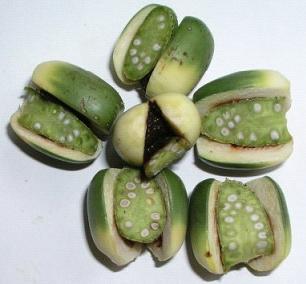
|
|
|
|
|
|
|
|
|
 |
|||
|
NUMBER:766, 2004 by Chun-yu Liu |
|
General Information Legal Cluster Bio-Geographic Cluster Trade Cluster Environment Cluster Other Clusters |

|
|
|
|
|
|
|
|
|
 |
|||
 I. Identification
I. Identification1. The Issue
Areca nuts have a nickname, "Green Golden", in Taiwan. The highest annual value of the amount of the areca nuts can be up to $505,987,878 USD. In recent years, especially after 1996, however, its corona is fading away, and even bears a notorious reputation, the main reason of causing the "debris flows" since most people believed that the areca is a major factor to damage the water and soil conservation. Besides, with Taiwan already in the WTO, a great number of cheaper areca nuts imported from Thailand may have a negative economic impact on areca farmers in the future. On the other hand, this is a great opportunity for the Taiwanese government to advise areca farmers to cultivate other plants and solve the severe environmental problem.
2. Description
What follows: 1. the definition of areca nuts 2. functions of areca nuts 3. the way of Taiwanese eating areca nuts 4. the health problem causing by eating areca nuts 5. social problems
According to The Encyclopedia
Americana International Edition:
Betel Nut: the seed of the betel palm (Areca catechu), which
is chewed as a stimulant throughout southern Asia. The betel nut is about 2
inches (5cm) long and is mottled brown and gray in color. The ripened seeds
are gathered between August and November, boiled in water, cut into slices,
and dried in the sun, giving them a dark brown or reddish color. Each dried
nut is then wrapped, together with a piece of shell lime, in a leaf of the betel
pepper (Piper betle) and chewed.
Betel nuts contain the alkaloid arecoline, a mild stimulant that produces a feeling of wellbeing. They are not habit-forming, but habitual chewing of betel nuts eventually blackens the teeth and may cause them to decay. In some parts of the Orient, betel nuts are used to destroy intestinal worms. Elsewhere, they are used as a dewormer in veterinary medicine.
According to The New Encyclopadia
Britannica:
Betel, also called Areca Nut, Pinang, or Penang, either of
two different plants whose fruit is used in combination for chewing, or masticatory,
purposes throughout wide areas of southern Asia and the East Indies. Betel chewing
is a habit of an estimated one-tenth of the world’s population. The betel nut
is the seed of the areca, or betel palm (Areca catechu), family Palmae, and
the betel leaf is form the betel pepper, or pan plant (Piper betle), family
Piperaceae.
The areca palm, cultivated in India,
Sri Lanka, Thailand, Malaysia, and the Philippines, has a slender, unbranched
trunk reaching 12 to 15 meters (40 or 50 feet) high and about 45 centimeters
(18 inches) in circumference and is topped by a crown of six to nine very large,
spreading, pinnate fronds. The fruit is about the size of a small hen’s egg.
Within its fibrous rind is the seed, or nut, the albumen of which is hard and
has a mottled gray and brown appearance.
The fruits of the areca palm, gathered between August and November, before they
are quite ripe, are husked, boiled in water, cut into slices, and dried in the
sun, becoming dark brown or black.
For chewing, a small piece of the
areca palm’s fruit is wrapped in a leaf of the betel pepper, along with a pellet
of shell lie or chunam to cause salivation and release the stimulating alkaloids.
In some cases cardamom, turmeric, or another aromatic is added for flavour and
stimulation. Chewing results in a copious flow of brick-red saliva, which may
temporarily dye the mouth, lips, and gums orange brown. Contrary to general
belief, the teeth of habitual chewers are not blackened by the betel juice,
but chewers often artificially stain the teeth black. Betel nuts are a source
of inferior catechu (q.v.); its chief alkaloid is arecoline, a drug used by
veterinarians as a worming agent.
Functions
of areca nuts
In each different era and society, it seems that areca nut changes role. In the ancient periods, the areca nut is an expensive food, and usually used to treat guests. That is why the term "areca nut" has a meaning of "guest" in Chinese. The pronunciation of the term, areca nuts, in Chinese is "Bing lan," and the meaning of the word "Bing" in Chinese character is similar with that of guest. In the Qing dynasty, areca nuts became a popular food, just like snacks, among nobles. In the Taiwanese native society, areca nuts present a significant culture to Taiwanese natives because they use areca nuts as a sacrificial offering in many kinds of ceremonies, such as the wedding, funeral, or other special days. Moreover, the areca nut is an indispensable gift. Every time when Taiwanese natives have an engagement or a wedding party, there must have areca nuts including in the gifts because for Taiwanese natives the areca nut presents love.
Another reason making areca nuts become a populous food in traditional Chinese society is its herbal function. According to a reliable ancient herbal books, Ben-Cao-Ji-Jing-Zhu, though the areca nut is bitter and pungent in taste, it has a high value to medical treatment and belongs to an expensive herbal medicine. The areca nut can efficiently cure constipation and abdominal fullness, reduce edema, and smooth your breathing, and antitussive. In many other herbal medical books, the areca nut is always described as a kind of Chinese traditional medicine. (http://e-info.org.tw/sunday/culture/2002/cu02011301.htm)
Moreover, according to The British Journal of Psychiatry, areca nut alkaloids include potent muscarinic cholinomimetics: recent research suggests that these agents may be therapeutic in schizophrenia. (http://bjp.rcpsych.org/cgi/content/full/177/2/174)
Except for the cultural and medical role, the immature areca nut can be made into dye, and the fiber of the mature areca nut is a great material for weaving a carpet. Furthermore, its trunk can be made furniture, the pillar, and the instrument.
The way of Taiwanese eating areca ntus:
The health problem causing by eating areca nuts:
Eating areca nuts is one major reason for Oral Cavity Cancer in Taiwan, since the present way of Taiwanese eating areca nut adds many relishes in it, such as the inflorescence and the leaf of the piper betel plant: and a paste of slaked lime. Each of these elements has its own purpose and effect, but, as combining together, when people are chewing areca nuts, these elements will produce a burning feeling in the cavity, and even damage your oral cavity tissue. In the long term, people eating areca nuts are much easier getting Oral Cavity Cancer than those do not eat areca nuts. According to research data, since the areca nut itself originally contains two significant alkaloids. Therefore, when areca nuts are added slaked lime, it is extremely possible to cause pathological changes of the oral cavity. In order to protect the youth, the Taipei city government had approved the "Taipei Municipal Self-Government Ordinance for Areca nuts."
Growing areca nuts in Taiwan became like the Gold Rush of the western America in 1830-- everyone started planting arecas in order to earn vast amounts of money. Competition getting intense, proprietors in Southern Taiwan created a new marketing campaign. Business cheated "Areca Hot Girls¡¨, women wearing skimpy or even transparent clothes, selling areca nuts. Quickly, more and more proprietors took this method to promote their areca nuts. The situation spread over the country just like a flood overflowing. This campaign also causes many kinds of social problems, such as pornography, and descending moral values. Areca nut culture became a unique culture in Taiwan, but one without much honor.
Poronography:
Pornography: There are two reasons may cause that Areca hot girls are easily
to be involved with pornography. First, most Taiwanese still have a traditional
concept that girl should not wear too skimpy, and this kind of girls must have
some problems, like their sexual attitude must be casual. Second, maybe only
a few areca hot girls use selling areca nuts to cover the sexual trend, but
once news papers and TV channel reported this thing, and then all areca hot
girls were tagged on the label, pornography.
3. Related Cases 
CASE NAME: PAKISTAN¡¦S LEATHER INDUSTRY
Summary: Because of the highly valued of leather, Pakistan¡¦s government encourage to develop internal leather industry. With the growth
of leather industry, however, also generates serious environmental degradation.
Case Name: Malawi Tobacco Industry and the Environment
Summary: Malawian government, by contrast, strongly supports the tobacco industry. However, with the developing of the tobacco industry causes the fastest rates of deforestation.
CASE NAME: Ghana Forest Loss
Summary: Timber is one important export product in Ghana. The over exploitation of timber causes many wood species lost.
CASE NAME: Thailand's Logging Ban
Summary: The Thai government decided to ban harvesting of timber because of a severe flood. It is similar with the reason why the
Taiwanese government starts to restrain the cultivation of arecas.
Legal:
CASE
NAME:
Coffee Exports from Costa Rica
Summary: Like arecas in Taiwan, coffee in Costa Rica is also a kind of highly
valued plant, and causes many environmental problems. Besides, the Costa Rica¡¦s
government established new laws and regulations to protect the environment,
too.
CASE NAME: India Tea and Environment
Summary: The habit of drinking tea in Asia is a tradition just like eating areca nuts. Tea is far more popular in Asian region than the areca nut. Let people know more about tea can complete their conception of the cultural part in my case.
CASE NAME:
Zimbabwe Tobacco Export and
Summary: In this case it mentions the anti-smoking trend in America and Western
Europe. As in Taiwan, there are always some anti-areca sounds, since eating
areca nuts harms our oral cavity.
Other:
CASE NAME: Nata
de Coco Boom and the Philippines
Summary: This case study is about nata de coco, a chewy, translucent, indigenous
dessert in the Philippines that is very popular in Japan. In 1993, Japanese
people, especially young people considered nata de coco a popular dessert, however,
its popularity declined because their interest moved to another trendy dessert.
CASE NAME: Taiga
Forest and Weyerhaeuse
Summary: Taiwan's trade in disposing of hazardous materials, particularly scrap
metal and car batteries, has a significant impact on its local environment and
population, and how this problem is now being shifted to China.
CASE NAME: Toxic Dumping
by Formosa Plastics Group in Cambodia (CAMWASTE)
Summary: In April, 1998, a Taiwanese plastics company finally reclaimed the
toxic waste it had illegally dumped in south-western Cambodia the previous year.
Formosa Plastics Group's mercury-laced shipment had been left in an exposed
heap just outside the coastal town of Sihanoukville, endangering the health
of local residents and causing an outcry in Cambodia.
4. Author and Date:
Chun-yu Liu, December, 2004
![]()
 II. Legal
Clusters
II. Legal
ClustersHere, we should focus on the (b) Import under tariff-rate quota (TRQ) because TRQ dircetly apply for the import of areca nuts. The details of the negotiations are as follows:
After Taiwan's accession to
the WTO, 22 formerly import banned agricultural products will be liberalized
under the TRQ schemes based on the Uruguay Round Agreement on Agriculture. These
items are peanuts, oriental pears, sugar, garlic bulbs, betel
nuts(= areca nuts), chicken meat, liquid milk, animal offal,
mackerel, adzuki beans, dried shiitake mushroom, pomelos, dried logans and logan
pulps, young coconuts, bananas, pineapples, mangoes, persimmons, carangid, sardine,
dried day lily, and pork belly. The import quota will account for 4% to 8% of
the domestic consumption (or sometimes higher, for sugar, 41%), and the tariff
rate will be 50% of the current rate. On the other hand, there is no quantity
restriction on the out-of-quota imports, but their tariff rates might be higher
than the current ones, depending on the base-year price difference between the
local and foreign markets and on the results of bilateral negotiations with
the countries concerned. Because of the high tariff rates, the impact of the
out-of-quota imports will not be significant in the first few years.
(source: Concil of Agriculture Executive Yuan, Taiwan,
http://www.coa.gov.tw/)
The import quota of areca nuts has increased from the first year 4,412 metric tons , occupying 4 percent of the domestic consuming number to the year of 2004, 8,824 metric tons, occupying 8 percent of the domestic consuming number. The tariff rate charging for the out-of-quota areca nuts has decreased from the first year 950 NTD per kilogram to the year of 2004, 810 NTD per kilogram.
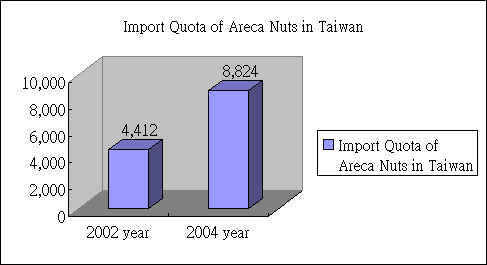

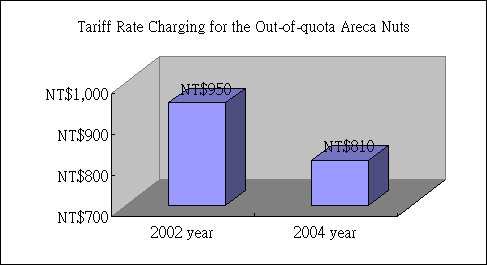
Even though the tariff rate charging for the out-of-quota areca nuts is decreasing, the government still can use special safeguard (SSG) to prevent dumping. By using SSG mechanism, the government not only can charge the original tariff of out-of-quota areca nuts but also have an extra tariff, one out of three tariffs, on those. The government can take SSG only if the importing number of areca nuts has accumulated over the basic quota or the importing price of areca nuts is below 10 percent of the domestic basic price of those.
The importing areca nuts are mainly from Thailand. It, however, does not have an apparent and direct influence of Taiwanese areca farmers in the short term. This is because of two reasons. First, the quality of Thai areca nuts is not as good as Taiwanese areca nuts, since Thai areca nuts have thicker fiber causing them taste worse than Taiwanese areca nuts. Second, Thai areca nuts are chiefly imported during the months that the nuts are shortage in Taiwan. Nevertheless, in the long run, with the advantage of cheaper price, Thai areca nuts will still have some kind of impact on Taiwanese areca farmers.
About Taipei Municipal Self-Government
Ordinance for Areca nuts:
In order to protect the health of the youth, on
September 29, 2003, the Taipei city government approved the "Taipei Municipal
Self-Government Ordinance for Areca nuts", and sent it to the Taipei city council
to examine. Once the ordinance is approved, each areca merchant wanting to open
a store must have a hygienic investigation examined by the city government.
Moreover, the ordinance also stipulates that people under 18-year-old cannot
eat areca nuts and the areca merchant cannot sell areca nuts to people under
18-year-old, either. People under 18-year-old violate the ordinance will be
handed over to the department of social welfare, Taipei government, and, according
to the level of violation, will be fined from the minimum of $303 USDto maximum
of $1,515 USD. People selling areca nuts to the youth will be fined from the
minimum of $90 USDto the maximum of $454 USD.
Although the ordination is only suitable for the Taipei city, areca merchants and farmers are extremely afraid that it may influence other counties and cities successively to approve similar regulations.
5. Discourse and Status: Disagreement and In Progress
6. Forum and Scope: WTO and Multilateral
7. Decision Breadth: Taiwan and
8. Legal Standing: Treaty
![]()
 III. Geographic Clusters
III. Geographic Clusters9. Geographic Locations
a. Geographic Domain: Eastern Asia
b. Geographic Site: Eastera Asia
c. Geographic Impact: Taiwan
10. Sub-National Factors: No
11. Type of Habitat: Tropical
![]()
 IV. Trade
Clusters
IV. Trade
Clusters12. Type of Measure: Culture
13. Direct v. Indirect Impacts: Direct
Taiwanese areca nuts only sell inside the country. After joined the WTO, Taiwan import areca nuts from Thailand. The quality of Thai areca nuts is not as good as Taiwanese areca nuts because of their thicker fiber. Therefore, it may not have an apparently and directly influence of Taiwanese areca farmers in the short term. Another reason is Thai areca nuts are chiefly imported during the months that the nuts are shortage in Taiwan. In the long run, however, with the advantage of cheaper price, Thai areca nuts will still have some kind of impact on Taiwanese areca farmers. The difference here is that the Taiwanese government would like to use this situation to help areca farmers cultivate some other plant, for the environment.
14. Relation of Trade Measure to Environmental Impact
a. Directly Related to Product: Yes, Areca Nuts
b. Indirectly Related to Product: Yes, Areca Nuts
c. Not Related to Product: No
d. Related to Process: Yes,
15. Trade Product Identification: Areca nuts
16. Economic Data
|
The Harvest of Areca Nuts within 5 Years |
||||||
|
|
1999 |
2000 |
2001 |
2002 |
2003 |
|
|
Planting Arecas(1000 hectares) Nan-ton county Bing-dong county Jia-yi county |
Total |
56.6 |
55.6 |
54.0 |
53.3 |
52.8 |
|
17.5 |
17.1 |
16.7 |
16.5 |
16.5 |
||
|
14.7 |
14.7 |
14.5 |
14.6 |
14.7 |
||
|
10.5 |
10.3 |
9.8 |
9.0 |
9.0 |
||
|
Areca of Harvest (1000 hectares) |
51.2 |
51.6 |
51.0 |
51.2 |
50.8 |
|
|
Total Yield (1000 hectares) |
170 |
167 |
165 |
162.3 |
159.6 |
|
|
Total Output Value of Per Hectare ($100,000,000 NTD) |
139.4 |
137.8 |
132.1 |
121.7 |
129.3 |
|
|
Output Value of Per Hectare(100,000 NTD) |
27.2 |
26.7 |
25.9 |
23.8 |
25.5 |
|
|
Cost of Production (Per Hectare, 10,000 NTD) |
17.8 |
16.9 |
16.8 |
15.4 |
14.9 |
|
|
Profit of Each Hectare (10,000NTD) |
9.4 |
9.8 |
9.2 |
8.4 |
10.6 |
|
|
The Number of Export (Ton) |
180.7 |
292.4 |
321.2 |
441.6 |
563.1 |
|
|
The Number of Import (Ton) |
-- |
-- |
-- |
905.6 |
1806.5 |
|
|
Data Source: Council of Agriculture Executive Yuan, Taiwan, Ministry of Finance, Taiwan Description: The areca is a perennial crop. In these years, the planting arecas are decreasing, but the arecas of harvest still have around 51,000 hectares. Its total value is also decreasing. However, it is still the second large crop in Taiwan. The first one is rice. Moreover, areca nuts in Taiwan mainly sell inside the country, though the export is increasing. The export, 563 tons, in 2003 only takes 0.4% of the total harvest ,and primarily sells for Hong Kong. |
||||||
17. Impact of Trade Restriction: Low
18. Industry Sector: Agriculture
19. Exporters and Importers: Thailand and Taiwan
![]()
 V. Environment Clusters
V. Environment Clusters20. Environmental Problem Type: Habitat Loss
The areca is not proper to plant near hillsides, though it is easy to plant, yet its roots cannot deeply get into the ground, and its roots will spread all over the ground making water hard to penetrate. Thus, once a typhoon or heavy rain breaks out, arecas cannot protect soil to be washed away by water. Furthermore, the ground does not have dead woods and defoliations to cover and this will cause the soil structure getting worse, so arecas is proper to plaint where has a thicker soil structure.
In Taiwan, however, the great fortune behind areca nuts attracted a lot of farmers to devote themselves to planting arecas, when the flat ground does not have enough place for planting arecas, then farmers started to plant arecas along hillsides. This situation buried a seed causing Taiwanese debris flows later.
The first time that the Taiwanese had a great impression on the debris flood was in 1996 after typhoon Herb. Each news channel continually repeated the scary scene of the debris flood. That is the earliest time most Taiwanese began to know the debris flood. Ever since that, the debris floods also became a nightmare for Taiwanese.
The government thought planting arecas in the hillside is one major reason causing successive debris flows recent years. Taiwan has a total land area of 3,600,618 hectares , consisting of 1,656, 427 hectares of mountain forests, which account for 46.00% of the total land area; 980,480 hectares of slopelands (27.23%); and 963,711 of plain areas (26.77%). Mountainous areas take up approximately three fourths of the total land area, while plain areas only account for one fourth of the total.
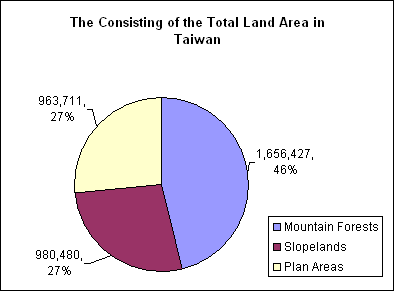
The prevalence of mountainous terrains over plain areas, steep topography, short and rapid rivers, dense distribution of torrents and gullies, and frequent earthquakes, coupled with torrential rains caused by the annual monsoon season and typhoons, contribute to unfavorable conditions such as fragile geology and soil. It is quite often that floods carrying sediment and rock erode land surface and cause collapses, landslides, debris flows, river scouring, and sedimentation. In addition to unfavorable natural conditions, debris flow disasters are further aggravated by social and environmental changes, human development and utilization, or inadequate soil and water conservation facilities.
Forests in Taiwan always take a great responsibility to the soil and water conservation. Within 50 years, however, forests in Taiwan had reduced 420,000 hectares, from 2,290,000 hectares in 1945 to 1,870,000 hectares in 1993. In this period, the area of areca farms had increased from 367 hectares to 54,000 hectares, and the growing rate was 149 times.
| County/City |
After the typhoon
Toraj, the total number of rivers, having high possibility to occur
debris flows |
Before the typhoon
Toraj, the total number of rivers, having high possibility to occur
debris flows (After the 921 earthquake) |
| Miao-li county |
70 |
61 |
| Tai-zhong county/city |
85 |
74 |
| Nan-tou county |
199 |
181 |
| Zhang-hua county |
7 |
6 |
| Yun-lin county |
9 |
8 |
| Jia-yi county |
43 |
40 |
| Total |
413 |
370 |

A rapidly moving mass of rock fragments, soil, and mud, with more than half of the particles being larger than sand size.
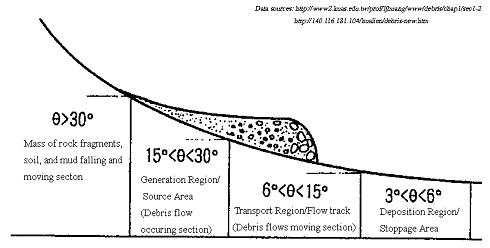
21. Name, Type, and Diversity of Species
Name: Areca
Type: A thin coconut
palm tree
22. Resource Impact and Effect: Low
and Scale
23. Urgency and Lifetime: High
and 10 years
24. Substitutes: Like
products
25. Culture: Yes
The history of eating areca nuts:
![]()
 VI. Other Factors
VI. Other Factors
The habit of eating areca nuts is a long tradition, and can be tracked back two thousand years in the Southeast Asian region, including India, Ceylon, Vietnam, Malaysia, and the Philippines. In Taiwan, Areca nut already was a populor food in the Qing dynasty. Besides, some native tribes in Taiwan have eatsn areca nuts for over two thousand years.
There is a story about the Taiwanese
areca nut:
A Long time ago, there were a twin native brothers living in Heng Chun.
Both of them fell in love with a native girl. When the younger brother found
that, he decided to quit, and secretly left home in the midnight. Unfortunately,
he fell in a valley and died. As the elder brother heard the news, he could
not believe this and dived in the valley, too. The news also spread to the native
girl. She was heartbreak, and also dived in the valley. After that, she became
a vine, and tightly held both of them forever.
This is a romantic aspect to see
the areca nut. Taiwanese have their specific way to eat areca nuts. They have
a special formula for the stuff putting in the middle of the areca nut. You
must chew all of these together, if lose any of these, and then the areca nut
will be tasteless.
26. Trans-Boundary Issues: N/A
27. Rights: N/A
28. Relevant Literature
Areca notebook, http://e-info.org.tw/sunday/culture/2001/culture01123001.htm
Tarshan Nature Laboratory, http://tnl.org.tw/
The Soil and Water Conservation Brueau, Taiwan, http://www.swcb.gov.tw
Council of Agriculture Executive Yuan, Taiwan, http://www.coa.gov.tw/